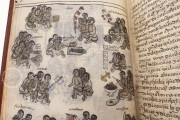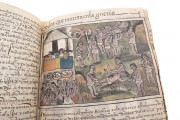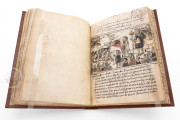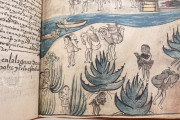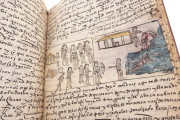The Michoacán Relation was made between 1539 and 1541 at Tzintzuntzan in the Lake Pátzcuaro region of west-central Mexico. It is a significant compilation of information concerning the history, beliefs, culture, politics, and civil and territorial structure of the people of Michoacán, known also as the Purépecha and by the Spanish as the Tarascan. Lively images and Spanish-language text combine to present an appreciation of indigenous history and the ethnology of the region. Its forty-four images portray local people and their history, at times employing visual devices borrowed from European art.
The manuscript's textual content was compiled from oral history and legend of the ruling Uanacaze dynasty reported by their descendants, as well as by non-Uanacaze witnesses to the region's history. The information was gathered by a Franciscan friar, identified as Jerónimo de Alcalá, at the behest of the viceroy of New Spain, Antonio de Mendoza, who also commissioned the Mendoza Codex.
Subjects Worthy of Grand Images
The opening image occupies most of its page: it shows Jerónimo in his Franciscan robe presenting his text to the viceroy seated on an elaborate throne (fol. 1r) entirely in the tradition of European dedication images. Most of the illustrations depict historical events, as well as aspects of the daily lives of the people, with religious and political leaders portrayed in traditional regalia.
The final image, which occupies a full page, is a remarkable adaptation of the Christian Tree of Jesse iconography to portray the lineage of the Uanacaze, extending from Thicatame, the founding lord, shown recumbent at the bottom of the image, to the present generation (fol. 140r). All the figures are identified by inscriptions in scrolls, and the order of their ascendency to rule is indicated by a continuous red line that loops through the tree's branches.
A Blending of Artistic Styles
The manuscript's drawings, many of which have painted frames like the miniatures of European manuscripts, are touched with color. The ubiquitous colors of indigenous manuscripts—red, green, light blue, and ocher—dominate, but orange, beige, and brown also appear. The figures are modeled in shades of gray. This represents a unique blend of echoes of traditional pictographic art and European techniques.
A Group Effort
Although Jerómino was responsible for amassing the manuscript's wealth of ethnographic information, the physical object was the work of four scribes and four artists, who may or not have been the four scribes. It is manifest that, as one would expect in a European manuscript of the time, the text was written first, with spaces reserved for the illustrations; toward the end of the manuscript, the illustrations were never executed.
An Ethnography in Three Parts
Although preserved in an incomplete state, we know from the prologue that the text was conceived in three parts. Part 1, of which only one leaf survives, presents information on religious ceremonies; Part 2 outlines the history of the people; and Part 3 describes the government before the arrival of the Spanish. Appended to the text of the Relation is a description of the ancient Mesoamerican calendar (fols. 141-143).
The manuscript was once owned by Diego González, prior of the community of Augustinian canons at Roncesvalles from 1575 to 1579.
We have 1 facsimile edition of the manuscript "Michoacán Relation": Relación de Michoacán facsimile edition, published by Testimonio Compañía Editorial, 2001
Request Info / Price










